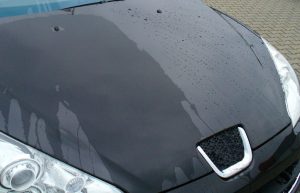How to remove mold from the interior
Written by: Vinnie van Rooij
Mold can be common in vehicles that have stood still for a long time, are often exposed to moisture or vehicles that are not cleaned often. Mold is not only unsightly but also dangerous for your health.
Contents
Why mold in a vehicle
Mold or mould is a fungus that grows in areas with high humidity. Food for example can contain liquids (fruit for example) that can accelerate the growth of the fungus. Within natural materials (like leather) it can cause biodegredation, breaking down the molecular structure of the material. Seats and dashboard can contain foam, this foam is often open cell, allowing air with a high humidity to reside inside the foam. It takes some time for the air to leave the foam, and to be replaced with dry air. This means that some parts of your interior can have a high humidity level, even when the interior seems dry and clean. This environment is perfect for the growth of mold. In severe cases, this can lead to large spots of fungus growing on your dashboard, the steering wheel and the seats.
How to remove mold
Removing mold can be a bit difficult. Mold is a fungus, meaning it is biological. Destroying biological material often means using dangerous chemicals, which are not very suitable for use inside a vehicles interior. Therefore rule number one should be to only work in a well ventilated area, to use respiratory protection and to let the interior dry out for several hours or days.
The use of gloves is very highly recommended, and if at all possible change clothes as soon as you are done with the removal.
Bleach
Bleach kills a lot of biological material, and is very good at killing mold. However, it also has an effect on the color of a material, bleaching carpets and seats. If wiped after with a damp cloth and some luke-warm water it can be used safely on a steering wheel and most parts of the dashboard. But there is also the risk of spilling or dripping it on the carpet. If you are going to use bleach, the average dose is 1:10 mixed with water.
Borax
This powdery substance is very effective at killing mold. It is toxic if ingested, but does not give off fumes or emits chemicals during normal use. Dilute borax 1:10 with water and apply with a brush. Scrub the surface and let it sit for a few minutes. Just before it has dried up, wipe off with a damp towel. Use a clean towel frequently to prevent spreading any mold.
Vinegar
Vinegar is a very versatile household product that can be used in many different areas of detailing. It is also cheap and easy to get, fully biodegradable and non-toxic. It just smells a bit bad. Spray the vinegar undiluted onto the surface, let it sit for a few minutes and just before it has dried up, wipe off with a damp cloth. Use clean cloths frequently.
Ammonia
Although ammonia works really well as a substitute for bleach, it doesn’t work very well on porous materials like carpets and seats. It also smells worse and takes longer to fully disappear. Mix ammonia 50/50 with water and spray it on the surface. agitate it with a brush and leave it for a few minutes. Just before it has dried up, wipe off with a damp cloth.
Detergent
Regular detergent can be used when the mold isn’t in any porous materials. You just need to remove the mold completely. This can either be done with a mixture of detergent and water, or you can use some APC and even a degreaser for this purpose.
Baking sode
Baking soda has the added benefit of removal odours besides killing mols. It can even be mixed with vinegar for a more effective product. One tablespoon of baking soda is enough for an average spraying bottle. If vinegar is added, change the total water volume to 50/50 vinegar and water. Spray the surface, agitate with a brush and leave it for a few minutes. Just before it dries up, wipe off with a damp cloth.
Denatured alcohol or IPA
On non-porous materials you can use denatured alcohol or IPA to clean the surface. This will kill most of the mold and make it easy enough to remove the remains. It will not be strong enough to kill mold inside the foam of seats, or the long fibers of a carpet.
Things to keep in mind
- Mold is dangerous for your health. Protect yourself and wash any tools you have used as soon as possible
- Mold will also get inside the seat, saturating the foam with your cleaning solution will be necessary to kill the mold inside the foam
- Using an extractor or wet/dry vacuum will make it much easier to clean the seats and carpet
- Mold can grow in places where it is not visible yet, it is important to be thorough
- It is important to let the interior dry out very well. If at all possible leave the vehicle with the doors wide open for several hours, preferably a day
- When using a vacuum it is recommended to use one with a HEPA filter
- Just because the carpet or fabric might feel dry, it can still be wet in the layer of padding underneath
- Considering replacing parts that are not very expensive (such as floormats)
- Just because you don’t see it anymore after wiping it off, doesn’t mean it is not there. The spores that might be left behind can cause mold te re-appear over time
Dangers of not removing mold
Mold has a direct effect on your health. Besides the surface damage it might cause, it will also make you sick and can have long terms effects when exposed to it for a long time. It is therefore very important to remove mold and to create a healthy and/or neutral environment. This also means that the person who is doing the removal should take good care in preventing his health becoming affected by the task at hand. Mold can get airborne and can be in places without visually showing itself. Protection and care as very important.
 Simoniz is an American brand of car detailing products that are being sold all around the world. They offer a wide range of products and services, aimed at creating a network of professional detailer who use their products....
Simoniz is an American brand of car detailing products that are being sold all around the world. They offer a wide range of products and services, aimed at creating a network of professional detailer who use their products.... Carbon Collective is an English manufacturer of different types of detailing products. The company is located in Daventry, England and has a distributor in America. They company has a selection of approved detailers and retailers in Europe and a distributor in America....
Carbon Collective is an English manufacturer of different types of detailing products. The company is located in Daventry, England and has a distributor in America. They company has a selection of approved detailers and retailers in Europe and a distributor in America.... Carlack is a Swiss manufacturer of car care products that has been making products since 1958. The brand is divided into 4 sections: Carlack, Aerolack, Yachtlack and Polylack, to cater for the need of several different type of surfaces and types of contaminants....
Carlack is a Swiss manufacturer of car care products that has been making products since 1958. The brand is divided into 4 sections: Carlack, Aerolack, Yachtlack and Polylack, to cater for the need of several different type of surfaces and types of contaminants.... Jewelultra is an English manufacturer from Kent that produces several different types of products for the professional automotive detailing scene. Their most popular product is likely to be Diamondbrite, a paint sealant. The company does not only offer products for car detailing, but also for industrial and janitorial industries....
Jewelultra is an English manufacturer from Kent that produces several different types of products for the professional automotive detailing scene. Their most popular product is likely to be Diamondbrite, a paint sealant. The company does not only offer products for car detailing, but also for industrial and janitorial industries.... In the field of protection, there are generally 4 groups of products: wax, sealant, hybrid and coatings. These products can be combined, but with mixed results. Knowing what the properties of a product are will clarify the end result....
In the field of protection, there are generally 4 groups of products: wax, sealant, hybrid and coatings. These products can be combined, but with mixed results. Knowing what the properties of a product are will clarify the end result.... Claylube is a specific liquid that helps to lubricate the surface when claying. Without this lube, the clay will leave a lot of marring due to it being fairly rough and having a very high level of friction when moving....
Claylube is a specific liquid that helps to lubricate the surface when claying. Without this lube, the clay will leave a lot of marring due to it being fairly rough and having a very high level of friction when moving....







[…] Mold In The Car […]
[…] How to Remove Mould, Algae, and Mildew From Your Car How to Remove Mold and Mildew from Cars How to remove mold from the interior Motor Car […]
[…] Mold In The Car […]
[…] maintenance, moisture control, and proper ventilation are key to keeping your car’s interior clean, healthy, and […]
[…] Adequate Ventilation: A well-ventilated car is less hospitable to mold. Use air conditioning and heating systems to deter moisture buildup. Consider using the […]